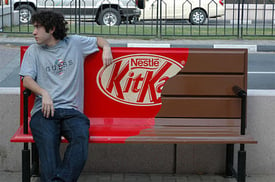Some forms of traditional advertising, like newspaper ads, have been around for over a hundred years. Advertising on other traditional media, like radio and television, became common in the 1960s. In the last 50+ years, traditional advertising has become the standard tactic by which most businesses engage with their audiences.
However, many marketers are now questioning the effectiveness of some of these channels. Direct mail has become increasingly expensive, while Tivo, Netflix and iPods have made it easy for consumers to skip right past TV ads. Is it any wonder that CMOs are looking for unique advertising strategies and channels?
What is Non-Traditional Marketing Exactly?
You most likely know what non-traditional advertising isn’t: it isn’t traditional advertising. But… what is it exactly? Simply put, non-traditional advertising is highly creative and uses unorthodox strategies with the goal of developing striking and memorable experiences that capture consumer interest. A lot of non-traditional marketing involves putting ads in unexpected or unusual places or displaying your messaging in ways that gets a lot of attention.
Why Consumers Respond to Non-Traditional Ads
People crave engagement, which is why they instinctively like non-traditional advertising and view it as more authentic and organic. There’s no denying that today’s consumer is more sophisticated and savvy, but definitely more skeptical and cynical as well. They are, by and large, immune to much of the traditional ads that are hurtling at them every second of every day.
Benefits of Going Non-Traditional
Besides knowing your audience will most likely respond favorably to your messaging, what other benefits do non-traditional ads offer?
These types of ads allow you to really target your specific demographic on THEIR territory. For instance, sneaker manufacturers might place ads on a public basketball court and diaper makers might place them in airport restrooms above the changing station.
Non-traditional advertising can also cost far less than traditional advertising channels like TV and radio spots, which, even in a local market, can costs thousands of dollars. A creative street market campaign can cost less than a hundred dollars with a potentially staggering ROI.
Challenges of Non-Traditional Advertising
While they can be cheaper, engaging, and highly targetable, non-traditional campaigns are also very unpredictable and hard to measure. Because it relies on tactics that fall way outside of traditional marketing, it’s typically hard to quantify a non-traditional campaign’s success or failure. Another potentially negative about this method is that, should your campaigns end up being confusing or just poorly executed, they may confuse your audience and create a negative brand image.
 Is Non-Traditional Right for Your Business?
Is Non-Traditional Right for Your Business?
At this point you may be thinking that this whole non-traditional marketing thing sounds pretty good and want to get started developing your first campaign. While many companies who deploy non-traditional campaigns have been major, national brands, smaller businesses can and have used this tactic with great results.
The only thing that is really needed is creativity and a clear vision of your campaign’s goals. If you currently have a limited marketing budget, using non-traditional marketing methods may be something to consider. Just remember to take into account that results can be unpredictable and although very affordable, you do risk wasting time and effort.
A Traditional and Non-Traditional Mix
Billions of dollars each year are spent on traditional advertising in this country, so we know that many of those channels are still working. Since traditional and non-traditional marketing strategies each have advantages and disadvantages, many marketers find success with a mix of both.
So how do you develop and deploy a non-traditional campaign? We’ve already mentioned that non-traditional marketing relies on numerous unknown factors, but that doesn’t mean you just slap a campaign together willy-nilly and launch it, hoping for the best. No, as with traditional campaigns, it is equally important to develop a comprehensive plan that will focus your efforts and give you the greatest chance at success.
Step 1: Define Your Audience
Your plan must start with defining exactly who your target audience is. This very step is going to help you determine whether a non-traditional approach even makes sense. Products with broad appeal tend to do the best with non-traditional tactics whereas products with limited appeal may not find much success with non-traditional campaigns.

Step 2: Select Your Specific Strategy
Don’t just pick a strategy out of the sky and think because it’s unique you can’t lose. You can lose, so select the strategy because you know it will impact your customers positively. Dig through market research to figure out the best way to align your message with your target demographic.
Step 3: Negotiate Deals
Once you know which channel you are going to employ, it’s time to negotiate deals so you can start placing ads in some unusual places. The tricky part is, since you are most likely showing ads in places they have never been shown before, you will need to be an artful negotiator. You may want to consider using a media buyer who has experience with placing non-traditional buys and let them negotiate with property owners on your behalf.
Step 4: Define Your Metrics
We’ve saved the most difficult step for last because, as we mentioned earlier, measuring non-traditional campaign success can be difficult. Whereas a direct marketing campaign has an obvious objective, typically to make more sales, a non-traditional campaign may be deployed to facilitate a brand makeover or simply get some buzz created for a new product line. You’ll still need to do your best to determine what indicators you will use to measure.
Non-traditional advertising can be a highly effective part of your overall media mix. Just make sure to do some research and plan accordingly to experience the biggest gains.
Related Posts:
- Are Traditional Advertising Channels Still Worth Your Time and Money?
- Local Advertising for Dummies
- 10 Proven Locan Advertising Ideas for Businesses
Image Credit: "The Economist: Brain Balloon" by Billy Siegrist is licensed under CC BY 2.0


